About R & D Centre

Research and Development Centre of IET Group is equipped with all facilities required for prototype development of educational instruments/kits and students research projects. Facilities like PCB designing, PCB processing, testing & calibration are available in this center. Repairing & maintenance facilities are available for most of instruments which are use in engineering and pharmacy colleges. Besides these facilities, the center has a good buffer stock of electronic & electrical components and tools.
Units of R & D
LCEDU (Low Cost Equipments Development Unit) :
At LCEDU, we have a great infrastructure, well experienced staff members and stock of electronic & electrical components and tools for in-house research and development work. The main objective of our unit is to develop various types of Low Cost Electronic Equipments / Kits in-house and make the product available in the market / institutions / organizations. Our equipments are specially designed as per the pattern of course curriculum of educational institutions and specially build to execute experiments effectively. Our products are very user friendly, simple in design, easy to repair, rugged & reliable and most important it’s available at affordable cost.
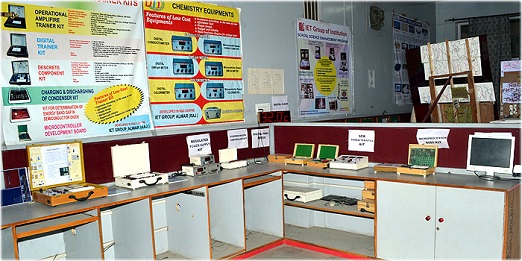

RMU (Repairing And Maintenance Unit) :
Team of technicians with facilities exists for the repairing of instruments and kits in this unit. This unit is capable to repair most of the instruments of all the departments. Electronic component measuring and calibration tools are available in the unit. This unit is capable to repair and calibrate the instruments/kits like CRO, function generator, different type of trainer kits (e.g. microprocessor trainer kit, microcontroller trainer kit, digital trainer kit, discrete trainer kit, op-amp trainer kit), all type of power supplies, measuring instruments, chemistry and physics lab instruments etc.
TEU (Technology Enhancement Unit) :
The basic objective of this programme is to initiate a self sustaining process to enhance the technical education. Special attention is given to activity based learning because ‘chalk and talk’ method is the weakest link in the current education system. The emphases remain on maximum use of multi-dimensional method of teaching/ learning (e.g. activity, demonstration by analogical modal, animated material and audio – visual aids etc) and Minimum use of one dimension (chalk and talk) method. This is the only way to encourage student to become innovative.

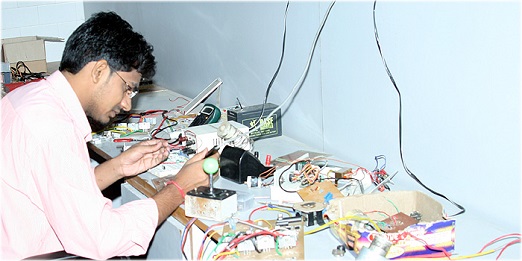
STPU (Student Training/Project Unit) :
This centre provides facilities for the training of student so that they can complete their
project fruitfully. In this unit computers are available with PCB designing software to design the project related PCBs,
matlab and labview software’s to simulate the circuits. Other facilities like PCB processing, SMD soldering and De- soldering,
Tool kits, buffer stock of components, testing and calibrating electronic equipment are also available.
Facilities exists with different development tools and compilers for 8/16/32 bits microcontroller:
1. Kiel development tool for 8/16/32 bits microcontroller and Emulator board of 8051 family
2. mikroC development tool for 8/16/32 bits microcontroller
BOA & Anvitha
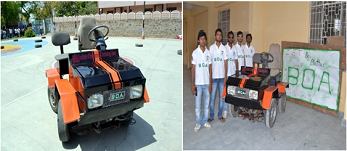
Introduction of BOA : BOA is an All Wheel Multi Steered Vehicle designed and built by a group of five mechanical engineering students of Institute of Engineering and Technology, Alwar, calling themselves as CHITTIES. The special steering is employed to improve steering response, increase vehicle stability while maneuraveing at high speed and to decrease turning radius at low speed. With all four wheels steered, the vehicle has a smaller turning radius than normal front steering vehicles. It enables crab steering where all four wheels turn in the same direction and the vehicle can move sideways without turning, thus improving straight line stability.
Aim & Objective of BOA : This project strives to produce an all wheel multi steered vehicle which help minimizing accidents due to rolling of the rear wheels over the bodies and reducing the turning radius by up to 25 percent by employing a self designed all wheel steering mechanism.
Achievements in the phase of project :
| Project Title | All Wheel Multi Steered Vehicle “BOA” |
|---|---|
| Description | Project involves design and development of an All Wheel Multi steered Vehicle with a mechanical steering control being provided on all four wheels. The steering mechanism apart from providing better control over the vehicle helps in minimization of road accidents. |
| Members | 5 |
| Award | 1st Runner up Kshitij, an Asia Level Tech Fest held in IIT Kharagpur Winner IOTA, Institute of Engineering and Technology, Alwar(Rajasthan) |
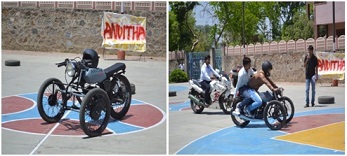
Introduction of Anvitha : The motorsports industry is increasing rapidly in the past 10 years. A large number of new variants of motorsports have been introduce thus making it an industry with wide range of sports or variants of motorsports ranging from formula 1 racing to motogp. Indian motorsports is not at all lack in any concept. In few years motorsports industry of Indian is at its full pace. Drag race, mud race, are becoming more common in country. Apart from these fun making sports, country is now with its own formula 1 team ‘Sahara force India’. These all shows that Indian peoples are interested in such sports and they are adopting these western sports.
By considering this and analyzing the data we thought of introducing a new concept of vehicle which can be equal and an active participant of motorsports events named “Anvitha”. Apart from the motorsports fun , the vehicle can be used in to make the day to day tedious tasks easy, providing and ergonomically correct and comfortable vehicle. “Anvitha” is a reverse trike vehicle i.e. a vehicle with two wheels at front and one wheel at rear. Innovative part of the vehicle includes a tilting/leaning mechanism provided into the vehicle that heips the vehicle to lean while making high speed turns like a two wheel vehicles. This concept provides various advantages over a non-leaning vehicle.
Achievements in the phase of project :
| Project Title | Tilting Reverse Trike “Anvitha” |
|---|---|
| Description | The project aims at development of a tilting Reverse Trike with self designed tilting mechanism. A TVS Maxx 100 bike is converted into a Reverse Trike having two wheels at front and one at rear. The trike is provided with a leaning/tilting mechanism which helps in leaning of the vehicle while making speed turns thus making smooth turns, increases the grip on road and combines features of both an automobile and bike. |
| Members | 3 |
Chain-less Bicycle

Introduction : A shaft-driven bicycle is a bicycle that uses a drive shaft instead of a chain to transmit power from the pedals to the wheel. Shaft drives were introduced over a century ago, but were mostly supplanted by chain-driven bicycles due to the gear ranges possible with sprockets and derailleur. Recently, due to advancements in internal gear technology, a small number of modern shaft-driven bicycles have been introduced.
Shaft-driven bikes have a large bevel gear where a conventional bike would have its chain ring. This meshes with another bevel gear mounted on the drive shaft. The use of bevel gears allows the axis of the drive torque from the pedals to be turned through 90 degrees. The drive shaft then has another bevel gear near the rear wheel hub which meshes with a bevel gear on the hub where the rear sprocket would be on a conventional bike, and canceling out the first drive torque change of axis.
Compressed Air Vehicle
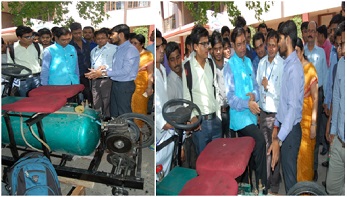
Introduction : When the project started we were hoping to discover something interesting. Because we wanted to give this world a green technology which by using natural forms of energy gives out an efficient form of output. It all started with a view to use air which is present all around us as fuel.
As the world is hard pressed with the energy and fuel crises, compounded by pollution of all kinds, any technologies that bring out the solutions to this problem is considered as a bounty. In one of such new technologies, is the development of a new engine called as compressed air engine which does not require any of the known fuels like diesel, petrol, CNG, LPG, hydrogen etc. this works using only compressed air. This replaces all types of to-date known fuels and also permanently solves the problems of pollution as its exhaust is clean and cool measured practically as low as 5ºC. A proto type, a horizontal, single cylinder low speed engine was modified to run on compressed air.
Since this engine runs only on high pressure compressed air, the exhaust of which is undoubtedly only air, making it a zero pollution engine. No heat is generated because there is no combustion of fuel, hence this engine needs no cooling system and it result in reduced cost, weight, volume and vibration. Early cost analysis shows that it's very cost effective and the operational cost is ten times less than that of petrol or diesel. Experimental analysis were carried out on this modified engine to find out its performance characteristics like brake power, mechanical efficiency, overall efficiency, air to Air ratio, volumetric efficiency, cost analysis etc. Though the efficiencies were low as the frictional forces were high for the proto designed engine, however the concept can be applied on a professionally designed engine to improve its performance.
Two-Pole Electric Motor

Introduction : Two of the three books mentioned in the lead-up to this page, "Model Making for Young Physicists" by A.D.Bulman and "The Boy Electrician" by Alfred P. Morgan, each presented a model which could be described as a "solenoid engine". The most obvious difference between them is that one of them (Bulman's) had only one solenoid, while Morgan's had two. The most obvious thing that they had in common is that they both relied on moving contacts.
Having built my two-pole electric motor, and thus knowing the hassles moving contacts can cause, I decided
in 2010 to build a solenoid engine built on very different principles.
Reduced to its bare essentials, a solenoid engine of the
moving-contact type can be represented as in the following diagram: At the right is the solenoid - a coil of wire wound on a tube of
suitable non-ferrous material with a movable soft-iron core. This is attached to a crankshaft (at left) which bears a slip-ring and
a cam, both made from some suitable metal (eg. brass) and electrically connected together.
Hot and Cold Dispencer
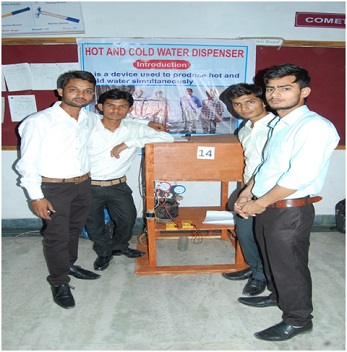
Introduction : Due to the increase in temperature of the earth due
to global warming, the use of air conditioners has drastically increased. Waste heat from air conditioners may be used to produce hot
water. The benefits of doing this are twofold. One is elimination of the need to install an electric water heater, and the other is
saving of electrical energy otherwise used in the electric water heater and water cooler. These may be accomplished while the usefulness
of the air conditioner for cooling is maintained.
At present, water heaters using waste heat from small split type air conditioners are commercially available in India and are generally
mechanically made to the specific requirements of the users. Even though split type air conditioners with water heaters are successfully
used, their performance and system design for application in India have not been fully investigated, especially when both cooling and
heating effects are desirable. The need for the development of an integrated air conditioning cum water dispenser system at low cost was
overcome by using a common compressor for both the systems. The use of common compressor eliminates the use of a separate electrical
energy for the operation of water heaters and water coolers. A parallel connection can be bypassed from the compressor of a normal air
conditioner in order to make the system suitable for all the three purposes i.e. water heating, water cooling and space conditioning.
In such a system there are two cycles involved: air cycle and water cycle. In evaporator of air cycle, the air is cooled. In condenser
of air cycle, the air is heated. In evaporating coil of water cycle, the water is cooled and in condensing coil of water cycle, the water
is heated. An attractive point is that this air conditioner cum water dispenser system can produce hot & cold water as well as hot &
cold air.
An instant hot water dispenser or boiling water tap is an appliance that dispenses water at about 94 °C (201 °F) (near-boiling). There
are hot-only and hot and cool water models, and the water may be filtered as well as heated. Instant hot water dispensers became popular
in the 1970s. Instant hot water dispensers are very similar to portable shower devices; the latter is fitted with a heating element and
quickly heats up water, once a switch has been activated.
Mini CNC Milling Machine
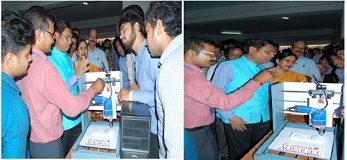
Introduction : Mini CNC Milling Machine is a economic trainer
milling machine. Which is devlop by our students for training purpose.
It is a very useful mechine to mini and small industries which can’t afford a heavy investment in CNC purchang and training.
It is also protable and easy to carry one place to another place. Milling opration and programming can be easily simulate as usaual
as actual production milling machine.

